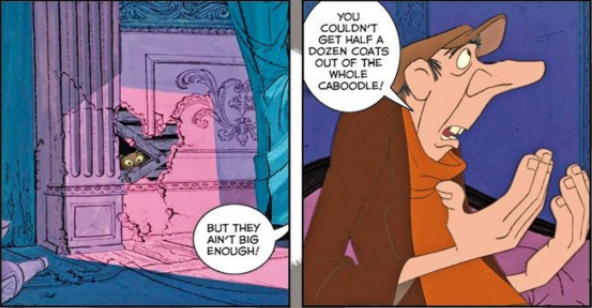There’s an important rule about shiurim:
כי הא דרבה, מקמי דפתח להו לרבנן אמר מילתא דבדיחותא, ובדחי רבנן. לסוף יתיב באימתא ופתח בשמעתא.
So:
Ted: What do you call a zoo that has only giraffes in it?
Ned: I don’t know. What?
Ted: Giraffic Park!
Seth: What do you call it when a giraffe swallows a toy jet?
Jake: Tell me.
Seth: A “plane in the neck.”
This week’s parasha is about building the משכן:
ג וזאת התרומה אשר תקחו מאתם; זהב וכסף ונחשת׃
ד ותכלת וארגמן ותולעת שני ושש ועזים׃
ה וערת אילם מאדמים וערת תחשים ועצי שטים׃
Most of those materials we understand. But what are ערת תחשים?
The term only appears a few times in תנ״ך. In the context of the משכן, they were used as the outermost cover:
ועשית מכסה לאהל ערת אילם מאדמים ומכסה ערת תחשים מלמעלה׃
And similarly when the vessels were moved:
ה ובא אהרן ובניו בנסע המחנה והורדו את פרכת המסך; וכסו בה את ארן העדת׃
ו ונתנו עליו כסוי עור תחש ופרשו בגד כליל תכלת מלמעלה; ושמו בדיו׃
ז ועל שלחן הפנים יפרשו בגד תכלת ונתנו עליו את הקערת ואת הכפת ואת המנקית ואת קשות הנסך; ולחם התמיד עליו יהיה׃
ח ופרשו עליהם בגד תולעת שני וכסו אתו במכסה עור תחש; ושמו את בדיו׃
ט ולקחו בגד תכלת וכסו את מנרת המאור ואת נרתיה ואת מלקחיה ואת מחתתיה; ואת כל כלי שמנה אשר ישרתו לה בהם׃
י ונתנו אתה ואת כל כליה אל מכסה עור תחש; ונתנו על המוט׃
יא ועל מזבח הזהב יפרשו בגד תכלת וכסו אתו במכסה עור תחש; ושמו את בדיו׃
יב ולקחו את כל כלי השרת אשר ישרתו בם בקדש ונתנו אל בגד תכלת וכסו אותם במכסה עור תחש; ונתנו על המוט׃
יג ודשנו את המזבח; ופרשו עליו בגד ארגמן׃
יד ונתנו עליו את כל כליו אשר ישרתו עליו בהם את המחתת את המזלגת ואת היעים ואת המזרקת כל כלי המזבח; ופרשו עליו כסוי עור תחש ושמו בדיו׃
And only once more, in יחזקאל. This is the section that we quote in the seder, the metaphor of בני ישראל as a lost, unclothed girl who is rescued by ה׳, ואמר לך בדמיך חיי ואמר לך בדמיך חיי.
וָאַלְבִּישֵׁ֣ךְ רִקְמָ֔ה וָאֶנְעֲלֵ֖ךְ תָּ֑חַשׁ וָאֶחְבְּשֵׁ֣ךְ בַּשֵּׁ֔שׁ וַאֲכַסֵּ֖ךְ מֶֽשִׁי׃
So presumably ערת תחשים are some kind of protective leather; likely waterproof, windproof and sandproof. But ערת of what? What is a תחש?
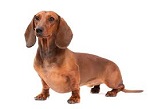
In modern Hebrew, a תחש is a dachshund. They’re cute, but they didn’t exist in the time of תנ״ך, and I don’t think they would make a good cover for the משכן. How the wiener dog got the name תחש is an interesting story. It starts with Rashi’s translation of the verse from יחזקאל:
ואנעלך תחש: א״י קלצי״י ט״י טיישו״ן בלע״ז. ויהיבית מסן דיקר ברגליכון.
“I shod you” translates in modern French to “je t’ai chaussé” and Latin to “ego calciavi te”“. You can see the first three words in there. An article in HaAretz claims טיישון is old French for ”badger", גירית in modern Hebrew:
בפירושו [של רש״י] לפסוק ”וָאַלְבִּישֵׁךְ רִקְמָה, וָאֶנְעֲלֵךְ תָּחַשׁ; וָאֶחְבְּשֵׁךְ בַּשֵּׁשׁ, וַאֲכַסֵּךְ מֶשִׁי“, כתב שהתחש הוא ”טייסון“—”גירית“ בצרפתית־יהודית של התקופה.
(in modern French, “badger” is “blaireau”, though in Spanish it’s “tejón” and in Occitan it’s “taisson”.)
The problem is that the words א״י קלצי״י ט״י טיישו״ן בלע״ז do not appear in the original manuscripts of Rashi, only in the later printed versions. They appear to be a editorial insertion. Where does it come from?

Martin Luther (German) translated tachash as a badger, and this appears in several famous translations (King James Version and the New King James Version). He based his translation on the assumption that Latin and German descended from Hebrew. In order to translate the Hebrew תחש, Luther looked for the phonologically corresponding form in German; hence, he arrived at Dachs, “badger”!
So we can reject badgers (even though that’s how the King James translates it). But dachshund?
מנדלי מוכר הספרים השריש את המילה תחש במשמעות זאת בקרב הדורות הראשונים של דוברי העברית בתרגומו ל”ספר תולדות הטבע“ של הראלד לנץ. באופן זה קיבל הכלב שנקרא בגרמנית (וכן באנגלית) Dachshund את שמו. תחילה תורגם השם ”כלב תחש“ וזה קוצר לתחש. כאשר חידש הזואולוג ישראל אהרוני את המילה ”גירית“ על פי הערבית ב-1923, היא דחקה את המילה ”תחש“ ששרדה רק בשם זו הכלב.
So תחש isn’t a dachshund. I don’t think those would work anyway.
A תחש is also the word for a dugong, the Indian-Ocean cousin of the manatee. In fact, the full name is the תחש המשכן.
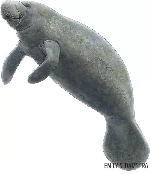
רבים הבינו שמדובר בסוג של חיה ימית…הדעה המקובלת יותר היא ביאור המילה על פי הערבית, שלאור המילה הדומה בשפה זו הגיעו למסקנה שמדובר ביונק הימי Dugong dugon. לאור מסקנה זו כינה חוקר הטבע הגרמני אדוארד ריפל (Eduard Rüppell) את החיה בשם הלטיני Halicore tabernaculi, ומשם הגיע השם גם לעברית—תחש המשכן.
תמיכה נוספת הוא מוצא בשם הערבי של התחש שהוא ”דארש“. עד היום הבדואים משתמשים בעור התחש על מנת לייצר סוליות, דבר המזכיר את הפסוק ”ואלבישך רקמה ואנעלך תחש וכו׳“.
Now, I haven’t found a modern source that translates dugong into Arabic as anything like דארש, and even that doesn’t sound much like תחש. The claim of an Arabic word comes, as far as I can tell, from the 1906 Brown–Driver–Briggs A Hebrew and English Lexicon of the Old Testament, and there it’s translated as “dolphin”. The modern Arabic word is الأطوم (al-utum).
Those are pretty weak. We have more clues about the תחש from the works of חז״ל (admittedly, much later).
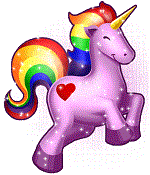
מאי הוי עלה דתחש שהיה בימי משה? אמר רבי אלעא אמר רבי שמעון בן לקיש, אומר היה רבי מאיר: תחש שהיה בימי משה בריה בפני עצמה היה, ולא הכריעו בה חכמים אם מין חיה הוא אם מין בהמה הוא, וקרן אחת היתה לו במצחו, ולפי שעה נזדמן לו למשה, ועשה ממנו משכן ונגנז.
So the תחש was a fantastic animal with a single horn that doesn’t exist: a unicorn! Using unicorn hides for luggage and shoes seems pretty frivolous. But the European mythological unicorn was based on a real animal, the rhinoceros, and its hide is the paragon of toughness and would be perfect for that:

- rhinoceros hide
- The tanned skin of a rhinoceros, used as a material.
- Figurative: insusceptibility to persuasion or argument; insensitivity to criticism; a ‘thick skin’.
The problem is the לפי שעה נזדמן לו למשה: rhinos exist in Africa and Asia and must have been known to בני ישראל.
But there’s another “unicorn” that fits the bill: the narwhal.

The narwhal (Monodon monoceros), or narwhale, is a medium-sized toothed whale that possesses a large “tusk” from a protruding canine tooth. It lives year-round in the Arctic waters around Greenland, Canada, and Russia.
It’s a marine mammal, so has a waterproof, tough hide. The reason that modern commentators reject it for the תחש is that it only exists in the Arctic, nowhere near the Sinai. But that means it fits the gemara! It is unique, a בריה בפני עצמה, has a קרן אחת (though not technically במצחו, more from its snout), and if ה׳ brought it to the Red Sea for the purpose of building the משכן, then you could say לפי שעה נזדמן and then נגנז. Not that it was created at that point and then ceased to exist, but it was prepared and then hidden away. I like the idea, though why the משכן would specifically need a unicorn I don’t know, though we’ve talked about the symbolism of קרן אחת במצחו before.
There are other opinions about the תחש:
וזאת התרומה וגו׳ ועורות אלים מאדמים ועורות תחשים: ר׳ יהודה ורבי נחמיה. ר׳ יהודה אומר: חיה טהורה גדולה היתה במדבר וקרן אחת היה לה במצחה, ובעורה ששה גוונים ונטלו אותה ועשו ממנה יריעות. ורבי נחמיה אומר: מעשה נסים היתה ולשעה שנבראת בו בשעה נגנזה..
So רבי נחמיה says it was לשעה נבראת, so back to the fantastic unicorn. ר׳ יהודה however says חיה טהורה גדולה היתה במדבר, it’s a real wilderness animal, large, with a multi-colored coat and a single horn. And it’s kosher! There’s an animal that seems to fit the bill: the giraffe.

Someone made reference to the giraffe being the legendary tachash, the skin of which was used to cover the Mishkan. This was indeed a theory that I quoted and favored in my book Mysterious Creatures. It is based on the Gemara identifying the tachash as the keres, which is described as having a single horn in the center of its forehead, which is indeed the case with some giraffes (which have two horns on top of their head and a single horn in the center).
…However, in the revised and expanded edition of that book, Sacred Monsters, I rejected identifying the tachash as the giraffe. I had gotten carried away with the ingenuity of the notion, while overlooking the fact that it wasn’t particularly reasonable. First, the Talmud’s statement that the keres satisfies the criterion that a kosher wild animal possess horns “even though it only has one horn” certainly seems to mean that it only has one horn, period, notwithstanding Maharam Shif’s creative explanation that it is only referring to its forehead. Second, the most distinctive feature of a giraffe is its height. It would be strange that in the description of the tachash and keres, no mention is made of that aspect.
Getting back to the kosher animal idea (which would eliminate the dugong, rhino and narwhal):
אמר רב אדא בר אהבה: תחש שהיה בימי משה קמיבעיא ליה טמא היה או טהור היה? אמר רב יוסף: מאי תיבעי ליה? תנינא: לא הוכשרו למלאכת שמים אלא עור בהמה טהורה בלבד! מתיב רבי אבא: רבי יהודה אומר שני מכסאות היו אחד של עורות אילים מאדמים ואחד של עורות תחשים; רבי נחמיה אומר מכסה אחד היה ודומה כמין תלא אילן. והא תלא אילן טמא הוא! ה״ק כמין תלא אילן, הוא שיש בו גוונין הרבה. ולא תלא אילן, דאילו התם טמא והכא טהור. א״ר יוסף א״ה היינו דמתרגמינן ססגונא ששש בגוונין הרבה.
ומשכי דדכרי מסמקי ומשכי ססגונא ואעי שטין .
Notice that ר׳ יוסף isn’t saying that ססגונא means שש בגוונין, ”happy with colors“; he’s saying that אי הכי, if the תחש had גוונין הרבה, then he would interpret the choice of the word ססגונא as being a hint to that idea. Rashi takes it more literally and adds some of the midrashim:
תחשים: מין חיה, ולא היתה אלא לשעה והרבה גוונים היו לה, לכך מתרגם ססגונא, ששש ומתפאר בגוונין שלו.
And once we focus on the colors of the ערת תחשים it changes our perspective. It’s not the animal that matters, but the color. ערת תחשים may be like ערת אילם מאדמים, dyed leather.
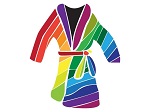
…”ועורות תחשים“.
ר׳ יהודא ור׳ נחמיה ורבנן. ר׳ יהודא אומר: טיינין לשם צובעו נקרא. ור׳ נחמיה אמר גלקטינין. ורבנן אמרין מין חיה טהורה, וגדילה במדבר.
…ר׳ אבהו בשם רבי שמעון בן לקיש בשם ר׳ מאיר: כמין חיה טהורה ברא הקב״ה למשה במדבר כיון שעשה בה מלאכת המשכן נגנזה. ר׳ אבון אמר: קרש היה שמה. תני רבי הושעיה: דחדא קרן (תהלים סט:לב) וְתִיטַב לַה׳ מִשּׁוֹר פָּר מַקְרִן מַפְרִיס.
Most commentators translate טיינין and גלקטינין as the names of colors or dyes. Similarly, the Septuagint:
Καὶ δέρματα κριῶν ἠρυθροδανωμένα καὶ δέρματα ὑακίνθινα καὶ ξύλα ἄσηπτα
rams' skins dyed red, blue skins, and incorruptible wood
- ὑακίνθινος
- hyacinthine
- From the Online Etymological Dictionary: Used in ancient Greece of a blue gem, perhaps sapphire, and of a purple or deep red flower, but exactly which one is unknown (gladiolus, iris, and larkspur have been suggested).
And the Jastrow dictionary relates ססגונא to a Persian word that means vermilion, sky-blue or blue-black (see Parshablog). In modern Hebrew, ססגוני in fact means “colorful”.
So the ערת תחשים, whatever animal they were made of, were colorful. Why does that matter?
I am not a chasid, but the Berdichever Rebbi has a wonderful answer:
עורות חחשים כו׳: כי לפעמים אדם מדבר מלתא
דבריחותא רק הפנימים הוא יראת שמים וכן
התחשים: החיציניות לא היה טוב אבל הפנימות היה טוב.
ומה שאומר היראה במלתא דבדיחותא הוא כדי שיקבל
האדם ממנו מחמת הבדיחותא; וזהו שתחרגם אונקלוס
על עורות תחשים ”ססגונא“ כלומר שמשמח את חבירו ועי״ז חבירו
מקבל ממנו הפנימית.
The cover of the משכן was meant to be fun, attracting the people to the serious spirituality within. And that’s why we start with a joke.
